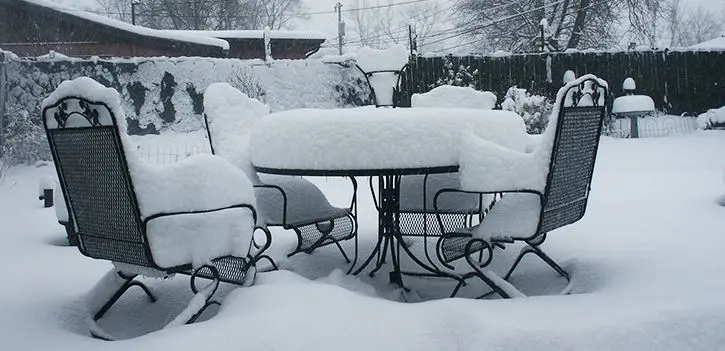What to Know Before Leaving Furniture Outside in the Winter
Winter can be a harsh season for outdoor furniture. Cold temperatures, wet conditions, and snow can all take a toll on patio furnishings. However, with the right care and protection, it is possible to leave your furniture outside during the winter months.
Before deciding to leave your furniture outside during the winter, consider the type of materials it is made from. Certain types of patio furniture, such as aluminum and synthetic wicker, are more resistant to winter weather than others like natural rattan and wood. Furniture made from these materials may require extra protection and care during the colder months.
To protect your furniture from the harsh winter weather, consider investing in furniture covers. These protective covers can shield your outdoor pieces from snow, ice, and freezing rain. Be sure to choose a cover that is specifically designed for outdoor furniture and fits your pieces well, leaving no gaps for water leaks. Secure the covers with bungee cords or other fasteners to ensure they stay in place during windy conditions.
Before putting the covers on, it’s also a good idea to clean your furniture with a soft brush and mild soap. If there are tough stains or bird droppings, try using dish soap to gently remove them. Apply a protective coating, such as a sealant, to wood furniture to prevent any damage to the material and to give it an added layer of protection.
Remember to store any removable cushions, pillows, or other accessories indoors during the winter season to prevent them from being damaged by the cold temperatures. If you do not have the storage space, consider wrapping them in plastic and sealing them tightly with tape to keep them dry.
Overall, leaving your patio furniture outside during the winter months is possible with the right materials and extra care. By following these tips and investing in protective covers, you can ensure that your outdoor furniture remains in good condition and ready to use when the warmer months return.
The Benefits of Keeping Furniture Outside in the Winter
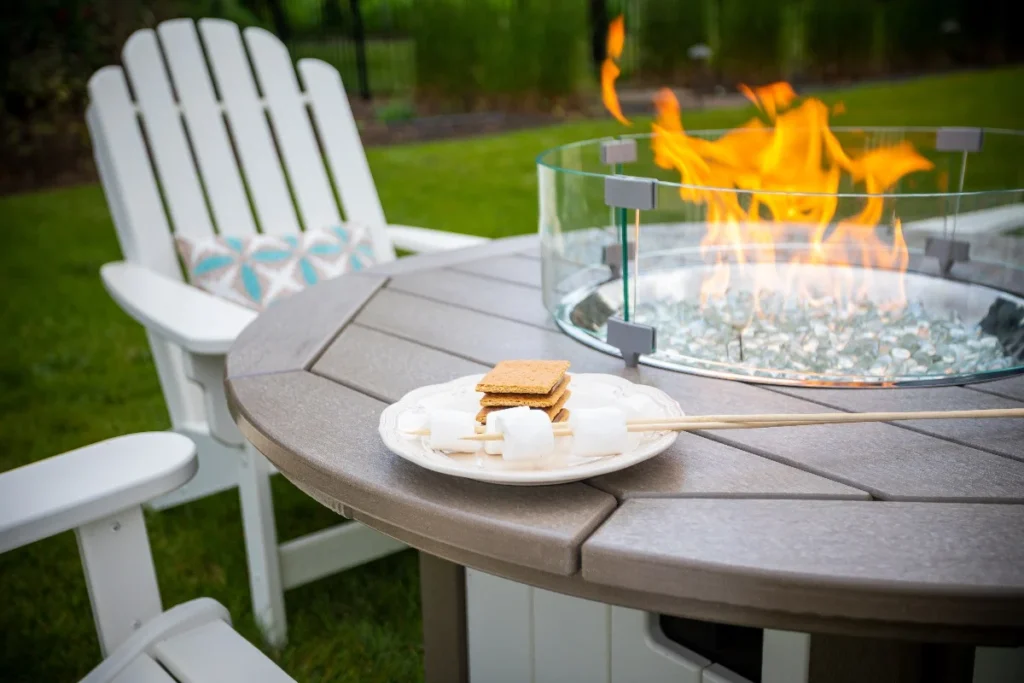
During winter, many people may choose to store their outdoor furniture inside in order to prevent damage from the cold weather. However, keeping your furniture outside during the winter months can actually have a number of benefits.
Firstly, keeping your outdoor furniture outside during the winter can free up valuable storage space inside your home. This can be particularly important for those with limited storage space or who are already struggling to keep their belongings organized.
Another benefit of keeping your outdoor furniture outside during the winter is that it can help to prevent damage to your furniture caused by the repeated cycles of heating and cooling that occur when furniture is stored indoors. Excessive exposure to warm, dry air during the winter months can cause wood to crack and joints to become loose. By keeping your furniture outside, you can help to maintain a more consistent temperature, which can help to prevent this type of damage.
In addition, many types of outdoor furniture are built to withstand the rigors of winter weather. Materials such as aluminum and synthetic wicker are particularly resistant to cold temperatures, making them ideal for winter use. These materials are also often designed to be easy to clean, meaning that you can simply wash them down with a mixture of warm water and dish soap in order to keep them looking their best.
Keeping your outdoor furniture outside during the winter can also allow you to make the most of your outdoor space, even in cold weather. By investing in some warm blankets and cushions, you can create a cozy outdoor seating area that is perfect for enjoying a cup of hot cocoa or catching up with friends in the crisp winter air.
In summary, while many people choose to store their outdoor furniture inside during the winter months, there are actually a number of benefits to keeping it outside. From freeing up valuable storage space, to preventing damage caused by temperature fluctuations, to allowing you to make the most of your outdoor space even in cold weather, there are many reasons why keeping your furniture outside during the winter can be a smart choice.
Types of Patio Furniture Material
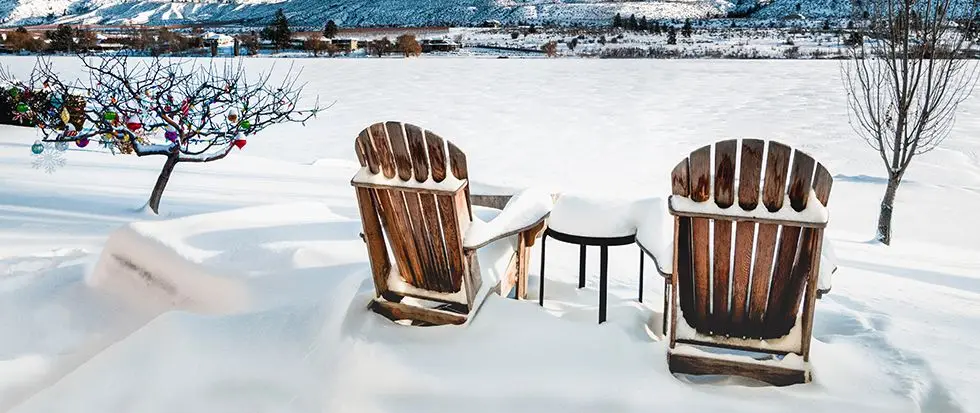
When it comes to choosing patio furniture, there are many different materials to consider. Each type of material has its own set of benefits and drawbacks, so it’s important to choose one that fits your needs and lifestyle. Here are some of the most common types of patio furniture material and what you need to know about them.
1. Wood – Wood is a classic choice for patio furniture and can lend a warm, natural feel to your outdoor space. However, not all wood is created equal. Some types of wood, such as teak, cedar, and redwood, are naturally resistant to insects and decay, making them ideal for outdoor use. Other types of wood may require regular sealing or treatment in order to protect them from the elements.
2. Metal – Metal patio furniture can be made from a variety of materials, including aluminum, steel, and wrought iron. Aluminum is lightweight and resistant to rust, while steel is strong and durable. Wrought iron is a classic choice that lends a sense of elegance to your outdoor space, but it can be heavy and require regular maintenance to prevent rust.
3. Resin – Resin patio furniture is made from a synthetic material that is lightweight and easy to clean. It is also typically less expensive than other types of patio furniture. However, resin furniture may not be as durable as other materials and can be prone to cracking or fading over time.
4. Wicker – Wicker patio furniture can be made from natural or synthetic materials. Natural rattan wicker is lightweight and durable, but it can be vulnerable to moisture damage. Synthetic wicker is often made from plastic or resin and is more weather-resistant, but it may not have the same natural look and feel of real wicker.
5. Fabric – Outdoor furniture cushions and pillows can be made from a variety of materials, including acrylic, polyester, and Sunbrella. Each material has its own set of benefits, such as UV resistance or water repellency. Be sure to choose cushions and pillows that are designed specifically for outdoor use in order to prevent mold or mildew growth.
Ultimately, the type of patio furniture material that you choose will depend on your personal preferences and needs. Consider factors such as durability, maintenance requirements, and weather resistance when making your decision. With the right patio furniture, you can create a comfortable and inviting outdoor space that you’ll love spending time in.
Plastic Furniture
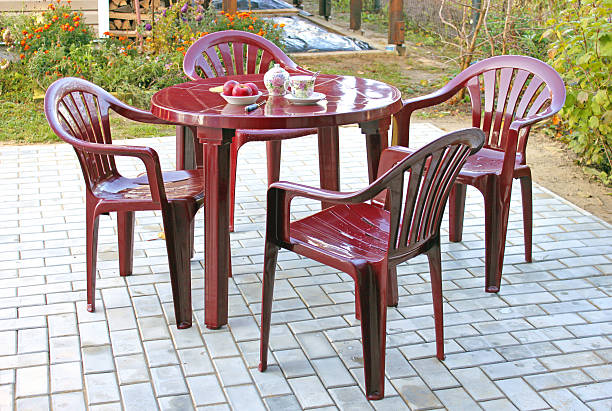
Plastic furniture is a popular and affordable option for outdoor spaces. It is lightweight, easy to clean, and resistant to the elements. Additionally, it comes in a wide variety of colors and styles, making it easy to find the perfect fit for any design scheme.
One of the biggest benefits of plastic furniture is its durability. Unlike wood or metal, plastic furniture does not rust, warp, or rot, making it ideal for use in wet conditions. It can also withstand exposure to UV rays without fading or discoloration.
Plastic furniture is typically made from high-density polyethylene (HDPE), which is a thermoplastic polymer that is known for its strength and durability. HDPE can be recycled, making it an eco-friendly option for those who are environmentally conscious.
Despite its many advantages, there are some precautions that should be taken when using plastic furniture. It is important to avoid placing plastic furniture near open flames or heat sources, as it can melt or warp under high temperatures. Additionally, care should be taken when cleaning plastic furniture to avoid scratching its surface.
One easy way to keep plastic furniture looking its best is to rinse it with warm water and mild soap. This can help to remove dirt and grime without damaging the plastic. If tougher stains are present, a soft brush can be used to scrub away dirt without causing damage.
Lastly, it is recommended to store plastic furniture indoors during the winter months to protect it from the cold temperatures and wet conditions that can cause it to crack or become brittle. If storage space is limited, be sure to cover the furniture with a protective cover or bungee cords to prevent water leaks and other damage.
In summary, plastic furniture is a durable, affordable, and eco-friendly option for outdoor spaces. With proper care and maintenance, it can provide years of use and enjoyment.
Aluminum Furniture
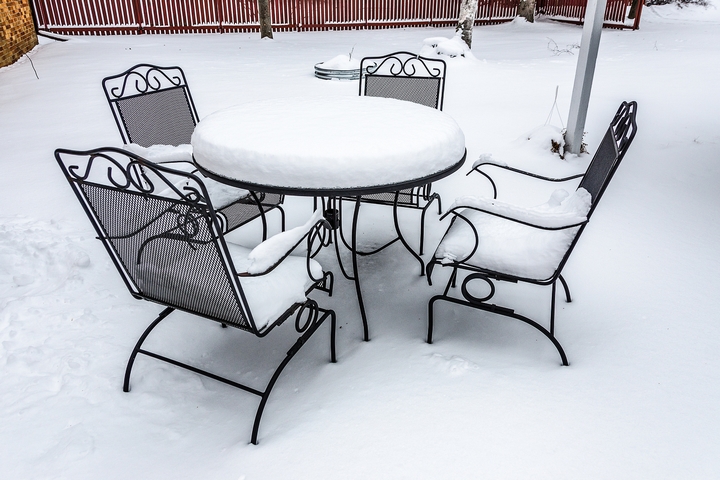
Aluminum furniture is a popular choice for outdoor patio areas due to its lightweight construction and resistance to rust and corrosion. This type of furniture is typically made from an aluminum alloy that is strong and durable, yet easy to work with. This makes it a great option for furniture manufacturers, as it can be easily shaped and molded to fit a variety of designs.
One of the biggest advantages of aluminum furniture is its resistance to rust and corrosion. This makes it an excellent choice for outdoor use, as it can withstand exposure to moisture and humidity without deteriorating or becoming damaged. Additionally, aluminum furniture is lightweight and easy to move, making it a great option for those who like to rearrange their outdoor spaces frequently.
When it comes to maintenance, aluminum furniture is relatively easy to care for. It can be cleaned with a mild soap and warm water, using a soft-bristled brush to remove any stubborn stains or dirt. However, care should be taken when using abrasive cleaners or scrub brushes, as they can scratch the surface of the aluminum and cause damage.
Aluminum furniture is also a great option for those who are environmentally conscious, as it can be recycled at the end of its lifespan. This can help to reduce waste and conserve natural resources, making it a more sustainable option than some other materials.
Despite its many advantages, there are some precautions to take when using aluminum furniture. It is important to avoid exposing the furniture to extreme temperatures, as this can cause it to warp or become damaged. Additionally, care should be taken when moving the furniture, as it can be easily dented or scratched if dropped or bumped.
Overall, aluminum furniture is a great choice for those who are looking for a durable and lightweight option for their outdoor patio areas. With proper care and maintenance, aluminum furniture can last for years and provide a comfortable and functional space for outdoor relaxation and entertainment.
Wood Furniture
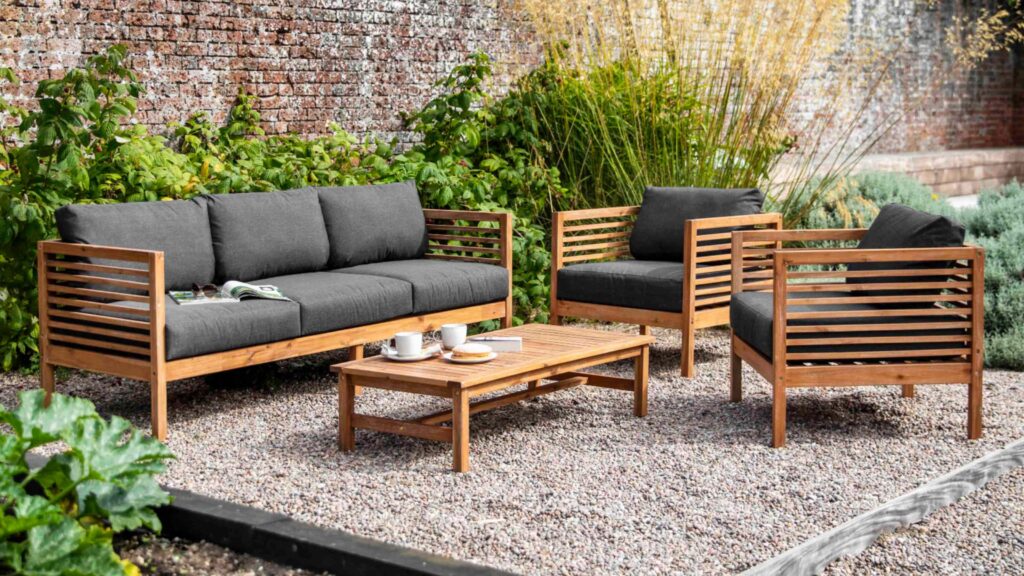
Wood furniture is a timeless option that can add warmth and character to any outdoor space. It is a popular choice for those who appreciate the natural beauty and durability of wood. However, when it comes to winter months, many people wonder whether it’s safe to leave their wood furniture outside.
The answer depends on the type of wood furniture you have and the conditions in your area. If you live in an area with harsh winter weather, it is generally not recommended to leave your wood furniture outside. The cold temperatures, snow, and ice can cause significant damage to your wood furniture, such as warping, splitting, or cracking.
To protect your wood furniture during the winter season, it is best to store it inside a clean, dry location. This could be a garage, shed, or another storage space that is protected from the elements. Make sure the furniture is clean and dry before storing it to prevent mold or mildew growth.
If you don’t have a storage space available, you could consider covering your wood furniture with an outdoor furniture cover. Make sure the cover fits snugly around the furniture and is made of a breathable material that will not trap moisture. Avoid using plastic covers or tarps, as these can trap moisture and cause further damage to your wood furniture.
Another option is to apply a protective coating such as a sealant or oil to your wood furniture before the winter season. This will provide an extra layer of protection against the cold weather and moisture.
When it comes to cleaning your wood furniture, use a gentle cleaning solution such as dish soap and warm water. Avoid using harsh chemicals or abrasives that can strip the finish or damage the wood. If your wood furniture has tough stains or bird droppings, you can use a soft brush and a mild solution of vinegar and water to remove them.
In conclusion, wood furniture is a beautiful and durable option for outdoor spaces, but it requires extra care during the winter season. Storing it inside or covering it with a protective cover are the best options to prevent damage. By taking these precautions and properly maintaining your wood furniture, you can enjoy its natural beauty for years to come.
Wicker Furniture

Wicker furniture is a popular choice for outdoor spaces, as well as indoor areas such as sunrooms and living rooms. Wicker furniture is made from weaving natural or synthetic materials such as rattan, bamboo, or synthetic fibers together to create a sturdy yet flexible frame.
One of the benefits of wicker furniture is its versatility. Wicker furniture comes in a variety of styles, colors, and patterns, making it easy to find a piece that fits your personal style and matches the existing decor of your space.
Natural wicker furniture is a bit more delicate and requires extra care to protect it from the elements. It is recommended to keep natural wicker furniture indoors or in a covered area to protect it from rain, snow, and other wet conditions.
Synthetic wicker furniture, on the other hand, is a great option for outdoor spaces as it is more durable and weather-resistant. Synthetic wicker is often made from materials such as resin or PVC, which can withstand harsh weather conditions and resist fading.
To keep your wicker furniture looking its best, regular cleaning is a must. Dirt and dust can settle into the woven fibers, making it difficult to clean and leading to potential damage over time. To clean your wicker furniture, use a soft brush and a mild soap solution. Avoid using harsh chemicals or abrasives, as these can damage the fibers and finish of the furniture.
When storing your wicker furniture, it is important to avoid stacking or squishing the pieces together, as this can cause the fibers to become misshapen or break. Instead, store the pieces individually or use the original packaging to protect them from dust and damage.
Overall, wicker furniture is a stylish and versatile choice for any indoor or outdoor space. With proper care and maintenance, your wicker furniture can remain a beautiful and functional part of your decor for years to come.
Caring for Outdoor Patio Furniture During the Winter Months
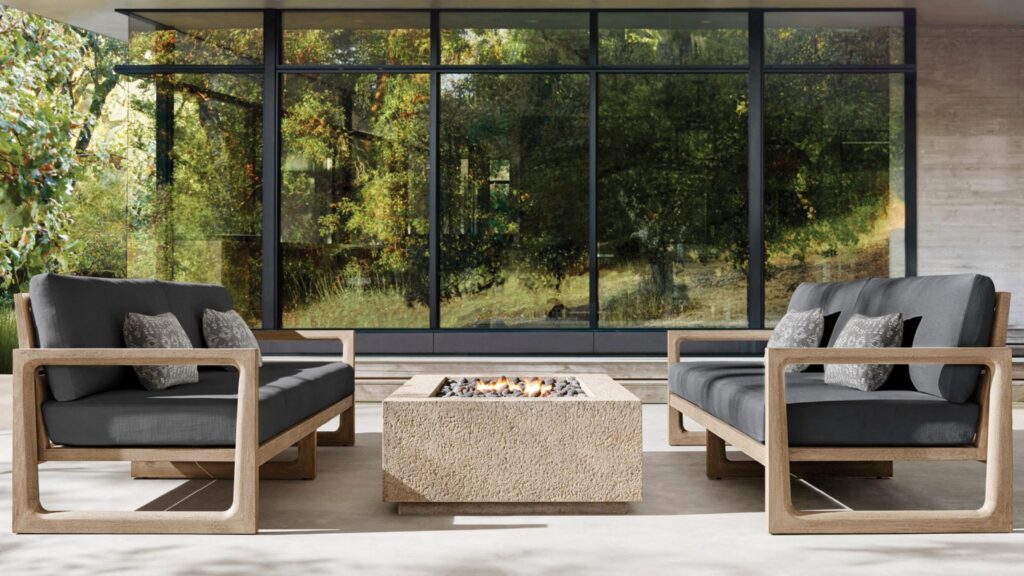
As the winter season approaches, it’s important to take extra care of your outdoor patio furniture. The cold temperatures, snow, and ice can cause damage to some types of materials, leading to a shorter lifespan for your furniture. However, with some extra protection and care, you can keep your outdoor furniture looking its best year after year. Here are some tips for caring for your outdoor patio furniture during the winter months.
1. Clean and Protect
Before the winter weather hits, give your furniture a thorough cleaning. Use warm water and a mild dish soap solution to gently wipe down each piece, taking care to remove any dirt or debris. For tough stains, you may need to use a specialized cleaner designed for outdoor fabrics or furniture.
Once your furniture is clean, consider applying a protective sealant or coating to help prevent damage from snow and ice. Some materials, such as wood or natural rattan, may benefit from a coat of protective oil or wax.
2. Cover it Up
When the weather turns cold, consider investing in a set of furniture covers. These specially designed covers help to protect your furniture from snow and ice, preventing water leaks and potential damage. Be sure to choose the right size cover for each piece of furniture, and use bungee cords or other methods to securely fasten the cover in place.
3. Choose the Right Materials
Not all patio furniture materials are created equal when it comes to cold weather. Some materials, such as aluminum or synthetic wicker, are more durable and resistant to damage from freezing temperatures. On the other hand, natural wicker or wood furniture may require extra care or storage during the winter months.
4. Create Storage Space
If possible, it’s always best to store your outdoor furniture indoors during the winter months. This provides the ultimate protection against the elements and can help prolong the life of your furniture. However, if indoor storage isn’t an option, consider creating a storage space outdoors. This can be as simple as a covered area or a shed.
By following these tips, you can help ensure that your outdoor patio furniture looks its best year after year. With a little extra care and attention, you can keep your investment protected from the harsh winter weather and enjoy it for many seasons to come.
Cleaning and Maintenance of Outdoor Patio Furniture
Outdoor patio furniture is a great addition to any backyard or outdoor space, allowing you to relax and unwind in the fresh air and sunshine. However, in order to keep your furniture looking its best and to prolong its lifespan, it’s important to regularly clean and maintain it. Here are some tips for cleaning and maintaining your outdoor patio furniture:
1. Know Your Material
Different types of outdoor patio furniture require different cleaning and maintenance methods. For example, aluminum furniture can be easily cleaned with warm water and mild soap, while wood furniture may require a specialized cleaner or protective sealant.
2. Clean Regularly
Regular cleaning is key to keeping your outdoor patio furniture looking its best. This includes removing any debris or dirt from the surface of the furniture, wiping down the material with a soft cloth, and applying a protective coating if necessary.
3. Protect from the Elements
Prolonged exposure to the elements can cause damage to your outdoor patio furniture, so it’s important to protect it from the wind, rain, and sun. This can be done by using a furniture cover, storing the furniture indoors during inclement weather, or simply bringing the cushions and other accessories inside.
4. Address Stains Promptly
Stains can quickly ruin the look of your outdoor patio furniture if left untreated. If you notice a stain, address it promptly using a specialized cleaner designed for your furniture’s material. For tough stains, you may need to enlist the help of a professional cleaner.
5. Take Extra Care with Natural Materials
Outdoor patio furniture made from natural materials such as wicker or rattan can be particularly vulnerable to damage from the elements. To ensure its longevity, take extra care to protect these materials from moisture and harsh weather conditions.
By following these simple tips for cleaning and maintaining your outdoor patio furniture, you can enjoy its beauty and functionality for years to come. So go ahead and kick back, relax, and enjoy your outdoor space!

